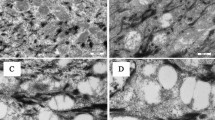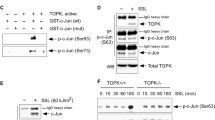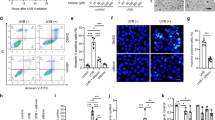Abstract
Studies from our laboratory have shown that epigallocatechin-3-gallate, the major polyphenol present in green tea, inhibits ultraviolet (UV)B-exposure-mediated phosphorylation of mitogen-activated protein kinases (MAPKs) (Toxicol. Appl. Pharmacol. 176: 110–117, 2001) and activation of nuclear factor kappa B (NF-κB) (Oncogene 22: 1035–1044, 2003) pathways in normal human epidermal keratinocytes. This study was designed to investigate the relevance of these findings to the in vivo situations in SKH-1 hairless mouse model, which is regarded to have relevance to human situations. SKH-1 hairless mice were topically treated with GTP (5 mg/0.2 ml acetone/mouse) and were exposed to UVB 30 min later (180 mJ/cm2). These treatments were repeated every alternate day for 2 weeks, for a total of seven treatments. The animals were killed 24 h after the last UVB exposure. Topical application of GTP resulted in significant decrease in UVB-induced bifold-skin thickness, skin edema and infiltration of leukocytes. Employing Western blot analysis and immunohistochemical studies, we found that GTP resulted in inhibition of UVB-induced: (i) phosphorylation of extracellular-signal-regulated kinases (ERK1/2), (ii) c-Jun N-terminal kinases, and (iii) p38 protein expression. Since NF-κB plays a major role in inflammation and cell proliferation, we assessed the effect of GTP on UVB-mediated modulations in the NF-κB pathway. Our data demonstrated that GTP inhibited UVB-induced: (i) activation of NF-κB, (ii) activation of IKKα, and (iii) phosphorylation and degradation of IκBα. Our data suggest that GTP protects against the adverse effects of UV radiation via modulations in MAPK and NF-κB signaling pathways, and provides molecular basis for the photochemopreventive effect of GTP in an in vivo animal model system.
This is a preview of subscription content, access via your institution
Access options
Subscribe to this journal
Receive 50 print issues and online access
$259.00 per year
only $5.18 per issue
Buy this article
- Purchase on Springer Link
- Instant access to full article PDF
Prices may be subject to local taxes which are calculated during checkout








Similar content being viewed by others
References
Adderley SR and Fitzgerald DJ . (1999). J. Biol. Chem., 274, 5038–5046.
Afaq F, Adhami VM, Ahmad N and Mukhtar H . (2002). Front. Biosci., 7, d784–d792.
Afaq F, Adhami VM, Ahmad N and Mukhtar H . (2003a). Oncogene, 22, 1035–1044.
Afaq F, Adhami VM and Ahmad N . (2003b). Toxicol. Appl. Pharmacol., 186, 28–37.
Afaq F and Mukhtar H . (2002). Skin Pharmacol. Appl. Skin Physiol., 15, 297–306.
Agarwal R, Katiyar SK, Zaidi SI and Mukhtar H . (1992). Cancer Res., 52, 3582–3588.
Ahmad N, Gupta S and Mukhtar H . (2000). Arch. Biochem. Biophys., 376, 338–346.
Ananthaswamy HN, Loughlin SM, Cox P, Evans RL, Ullrich SE and Kripke ML . (1997). Nat. Med., 3, 510–514.
Bachelor MA, Silvers AL and Bowden GT . (2002). Oncogene, 21, 7092–7099.
Baeuerle PA and Baltimore D . (1988). Science, 242, 540–546.
Baeuerle PA and Baltimore D . (1996). Cell, 87, 13–20.
Balasubramanian S, Kim KH, Ahmad N and Mukhtar H . (1999). Oncogene, 18, 1297–1302.
Baldwin AS . (1996). Annu. Rev. Immunol., 14, 649–683.
Bost F, McKay R, Dean N and Mercola D . (1997). J. Biol. Chem., 272, 33422–33429.
Carter AB, Knudtson KL, Monick MM and Hunninghake GW . (1999). J. Biol. Chem., 274, 30858–30863.
Cavigelli M, Dolfi F, Claret FX and Karin M . (1995). EMBO J., 14, 5957–5964.
Chang L and Karin M . (2001). Nature, 410, 37–40.
Chen N, Ma W, Huang C and Dong Z . (1999). J. Biol. Chem., 274, 15389–15394.
Chen W, Borchers AH, Dong Z, Powell MB and Bowden GT . (1998). J. Biol. Chem., 273, 32176–32181.
Chen W, Tang Q, Gonzales MS and Bowden GT . (2001). Oncogene, 20, 3921–3926.
Chen YC, Shen SC, Lee WR, Lin HY, Ko CH and Lee TJ . (2002). J. Cell. Biochem., 86, 331–339.
Chouinard N, Valerie K, Rouabhia M and Huot J . (2002). Biochem. J., 365, 133–145.
Clydesdale GJ, Dandie GW and Muller HK . (2001). Immunol. Cell Biol., 79, 547–568.
de Gruijl FR . (2002). Skin Pharmacol. Appl. Skin Physiol., 15, 316–320.
Derijard B, Hibi M, Wu IH, Barrett T, Su B, Deng T, Karin M and Davis RJ . (1994). Cell, 76, 1025–1037.
Dhar A, Young MR and Colburn NH . (2002). Mol. Cell. Biochem., 234-235, 185–193.
Dubois B, Lamy PJ, Chemin K, Lachaux A and Kaiserlian D . (2001). Cell. Immunol., 214, 173–183.
Elmets CA, Singh D, Tubesing K, Matsui M, Katiyar SK and Mukhtar H . (2001). J. Am. Acad. Dermatol., 44, 425–432.
F’guyer S, Afaq F and Mukhtar H . (2003). Photoderm. Photoimmunol. Photomed., 19, 56–72.
Garg A and Aggarwal BB . (2002). Leukemia, 16, 1053–1068.
Gensler HL and Welch K . (1992). Carcinogenesis, 1, 9–13.
Greenlee RT, Murray T, Bolden S and Wigo PA . (2000). CA Cancer J. Clin., 50, 7–33.
Hildesheim J, Bulavin DV, Anver MR, Alvord WG, Hollander MC, Vardanian L and Fornace Jr AJ . (2002). Cancer Res., 62, 7305–7315.
Huang C, Ma W, Bowden GT and Dong Z . (1996). J. Biol. Chem., 271, 31262–31268.
Huang C, Ma WY, Young MR, Colburn N and Dong Z . (1998). Proc. Natl. Acad. Sci. USA, 95, 156–161.
Iordanov M, Bender K, Ade T, Schmid W, Sachsenmaier C, Engel K, Gaestel M, Rahmsdorf HJ and Herrlich P . (1997). EMBO J., 16, 1009–1022.
Iordanov MS, Choi RJ, Ryabinina OP, Dinh TH, Bright RK and Magun BE . (2002). Mol. Cell. Biol., 22, 5380–5394.
Jemal A, Devesa SS, Fears TR and Hartge P . (2000). J. Natl. Cancer Inst., 92, 811–818.
Kang S, Chung JH, Lee JH, Fisher GJ, Wan YS, Duell EA and Voorhees JJ . (2003). J. Invest. Dermatol., 120, 835–841.
Karin M . (1995). J. Biol. Chem., 270, 16483–16486.
Katiyar SK, Afaq F, Azizuddin K and Mukhtar H . (2001a). Toxicol. Appl. Pharmacol., 176, 110–117.
Katiyar SK, Afaq F, Perez A and Mukhtar H . (2001b). Carcinogenesis, 22, 287–294.
Katiyar SK, Agarwal R, Wood GS and Mukhtar H . (1992). Cancer Res., 52, 6890–6897.
Katiyar SK, Elmets CA, Agarwal R and Mukhtar H . (1995). Photochem. Photobiol., 62, 855–861.
Katiyar SK, Korman NJ, Mukhtar H and Agarwal R . (1997). J. Natl. Cancer Inst., 89, 556–566.
Katiyar SK and Mukhtar H . (2001). J. Leukoc. Biol., 69, 719–726.
Katiyar SK, Perez A and Mukhtar H . (2000). Clin. Cancer Res., 6, 3864–3869.
Kaufman CK and Fuchs E . (2000). J. Cell Biol., 149, 999–1004.
Kim J, Hwang JS, Cho YK, Han Y, Jeon YJ and Yang KH . (2001). Skin Pharmacol. Appl. Skin Physiol., 14, 11–19.
Kyriakis JM and Avruch J . (2001). Physiol. Rev., 81, 807–869.
Learn DB, Beard J and Moloney SJ . (1993). Photodermatol. Photoimmunol. Photomed., 9, 147–153.
Lefort K, Rouault JP, Tondereau L, Magaud JP and Dore JF . (2001). Oncogene, 20, 7375–7385.
Maniatis T . (1997). Science, 278, 818–819.
Milne DM, Campbell LE, Campbell DG and Meek DW . (1995). J. Biol. Chem., 270, 5511–5518.
Mittal A, Elmets CA and Katiyar SK . (2003). Carcinogenesis, 24, 1379–1388.
Mukhtar H and Elmets CA . (1996). Photochem. Photobiol., 63, 356–357.
Nghiem DX, Kazimi N, Mitchell DL, Vink AA, Ananthaswamy HN, Kripke ML and Ullrich SE . (2002). J. Invest. Dermatol., 119, 600–608.
Nomura M, Kaji A, He Z, Ma WY, Miyamoto K, Yang CS and Dong Z . (2001). J. Biol. Chem., 276, 46624–46631.
Potapova O, Gorospe M, Bost F, Dean NM, Gaarde WA, Mercola D and Holbrook NJ . (2000). J. Biol. Chem., 275, 24767–24775.
Potapova O, Basu S, Mercola D and Holbrook NJ . (2001). J. Biol. Chem., 276, 28546–28553.
Read MA, Whitley MZ, Gupta S, Pierce JW, Best J, Davis RJ and Collins T . (1997). J. Biol. Chem., 272, 2753–2761.
Scharffetter–kochanek K, Wlaschek M, Brenneisen P, Schauen M, Bladschun R and Wenk J . (1997). Biol. Chem., 378, 1247–1257.
She QB, Ma WY, Zhong S and Dong Z . (2002). J. Biol. Chem., 277, 24039–24048.
Stahl W and Sies H . (2002). Skin Pharmacol. Appl. Skin Physiol., 15, 291–296.
Su B and Karin M . (1996). Curr. Opin. Immunol., 8, 402–411.
Thanos AM and Maniatis T . (1995). Cell, 80, 529–532.
Vink AA, Moodycliffe AM, Shreedhar V, Ullrich SE, Roza L, Yarosh DB and Kripke ML . (1997). Proc. Natl. Acad. Sci. USA, 94, 5255–5260.
Wang ZY, Agarwal R, Bickers DR and Mukhtar H . (1991). Carcinogenesis, 12, 1527–1530.
Xia Z, Dickens M, Raingeaud J, Davis RJ and Greenberg ME . (1995). Science, 270, 1326–13231.
Yamazaki S, Muta T and Takeshige K . (2001). J. Biol. Chem., 276, 27657–27662.
Yang CS, Maliakal P and Meng X . (2002). Annu. Rev. Pharmacol. Toxicol., 42, 25–54.
Zhu WH, MacIntyre A and Nicosia RF . (2002). Am. J. Pathol., 161, 823–830.
Author information
Authors and Affiliations
Corresponding author
Rights and permissions
About this article
Cite this article
Afaq, F., Ahmad, N. & Mukhtar, H. Suppression of UVB-induced phosphorylation of mitogen-activated protein kinases and nuclear factor kappa B by green tea polyphenol in SKH-1 hairless mice. Oncogene 22, 9254–9264 (2003). https://doi.org/10.1038/sj.onc.1207035
Received:
Revised:
Accepted:
Published:
Issue Date:
DOI: https://doi.org/10.1038/sj.onc.1207035
Keywords
This article is cited by
-
The green tea polyphenol EGCG potentiates the antiproliferative activity of sunitinib in human cancer cells
Tumor Biology (2016)
-
Dietary phytochemicals alter epigenetic events and signaling pathways for inhibition of metastasis cascade
Cancer and Metastasis Reviews (2014)
-
PPARδ Inhibits UVB-Induced Secretion of MMP-1 through MKP-7-Mediated Suppression of JNK Signaling
Journal of Investigative Dermatology (2013)



